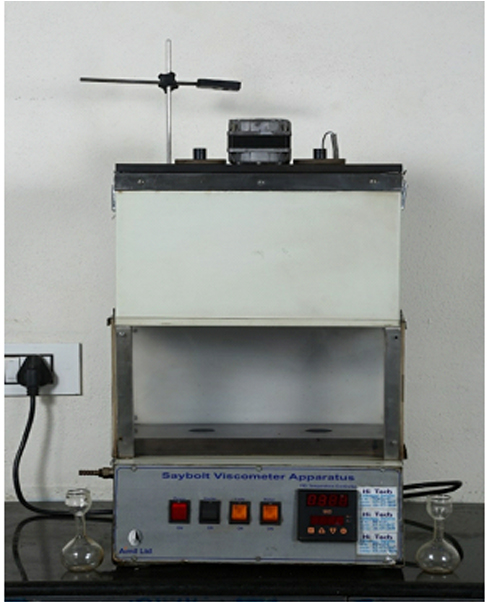Tests on Emulsion
Viscosity by Saybolt Viscometer
Code: This test is done as per IS: 3117-2004.
Procedure:
- i) Clean the oil tube with a solvent, such as benzene, and remove excess solvent from the gallery. Pass the entire material through a 150 micron wire strainer before introducing into the oil tube.
- ii) After the tube is cleaned, pour into the tube a quantity of the material to be tested, sufficient to wet the entire surface of the tube. Allow to drain out.
- iii) The plunger commonly supplied with the viscometer shall never be used on instruments maintained as standards. Insert the cork stopper not less than 6.0 mm and not more than 9.5 mm into the lower end of the air chamber at the bottom of the oil tube, taking care that the cork fits tightly enough to prevent the escape of air, as tested by the absence of oil on the cork after it is withdrawn.

- iv) If the test temperature is above that of the room, heat the material to not more than 1.50C below the temperature of test.
- v) Pour the material into the oil tube until it ceases to overflow into the gallery. Keep it well stirred with the oil tube thermometer, care being taken to avoid touching the outflow tube. Adjust the bath temperature until the temperature of the material remains constant.
- vi) After thermal equilibrium has been attained, no further adjustment shall be made in the bath temperature. The test results shall be discarded if the indicated bath temperature varies by more than +0.030C.
- vii) After the temperature of the material in the oil tube has remained constant within +0.020C of the desired temperature for one minute with constant stirring, withdraw the oil tube thermometer and remove the surplus liquid quickly from the gallery by means of the withdrawal tube so that the level of the material in the gallery is below the level in the oil tube proper. Insert the tip of the withdrawal tube at one point in the gallery.
- viii) The test shall be started over again if the tip of the withdrawal tube touches the overflow rim. Under no condition shall the excess liquid be removed by rotating the withdrawal tube around the gallery.
- ix) Place the receiving flask in position so that the stream of liquid from outlet tube strikes the neck of the flask, care being taken that the graduation mark on the receiving flask is not less than 10cm, not more than 13cm, from the bottom of the bath. Snap the cork from its position and at the same instant start the timer. Stop the timer when the bottom of the meniscus of the liquid reaches the mark on the neck of the receiving flask.
- x) Time in seconds as determined by the prescribed procedure, with the proper calibration correction, is the Saybolt Furol viscosity of the material at the temperature at which the test is made.
- xi) Report the results to the nearest 0.1 second for viscosity values below 200 seconds and to the nearest whole second for values 200 seconds or above.
Uses:
To determine the softening point of bitumen.

